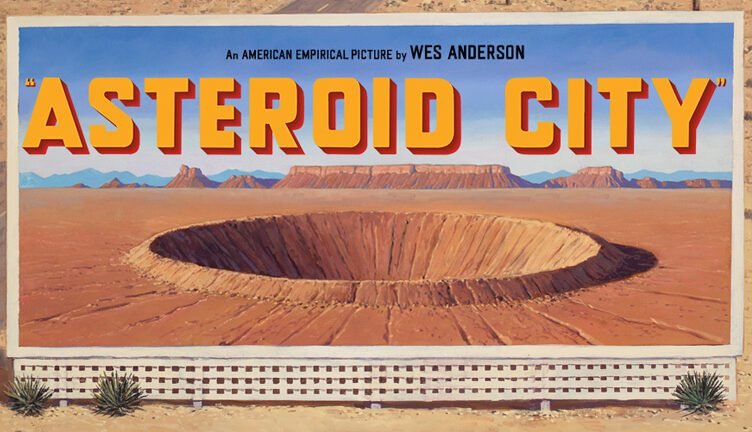Miss the beat/you lose the rhythm/And nothing falls into place,” quoth Sammy Hagar.
Never thought I’d open a review with a Van Halen lyric, much less one from the Hagar era (though it is *gulp* my preferred VH era), but here we are.
I was as enthused as any film nerd worth their nerd salt to see Wes Anderson’s newest work, Asteroid City. I couldn’t wait to get lost in his diorama-esque mise en scène, pastel cinematography, and deadest of deadpan humor, but as Asteroid City opened on a black and white image confined to a square 4:3 aspect ratio (with the sides squished in a bit), my brain revolted, “What is this shit?!”
Ignoring my questionable professionalism for a moment, the point I’m trying to make is that within seconds of the movie starting, I had already missed a beat.
And you know–thanks to Mr. Hagar–what happens when you miss a beat.
It just started; Did I already miss the rhythm?
Yep.
Was nothing going to fall into place?
Hmmmm.
Up on the screen, still in that monochrome gray, Bryan Cranston appeared as a Rod Serling-like narrator, a host of a 1950’s looking tv show (I think?), describing a play that we’re about to see, which, it turns out, was the Asteroid City we’d been promised by the trailers. After an unhelpful “Act I, scenes i – iii” title card, the movie proper begins, switching to a cinemascope frame stretching narrowly across the screen, filled with the meringue cinematography I was hoping for.
We were on more familiar ground. I hoped for the best. Maybe the black and white intro was just a throat clearing that held little importance. Maybe I could still catch up with what the movie was doing.
Nope.
The black and white sequences pop up frequently throughout the narrative, raising the meta quotient with each return as they introduce the writer, director, and actors of the Asteroid City “play” that we’re ostensibly seeing in color. I spoke too soon when I called the color scenes the “movie proper.” The black and white opening wasn’t a throwaway. Clearly, the monochromed sequences were part of the main event also.
But what did it all mean? What did this nested doll storytelling add to the tale?
Dear reader, if you think I’m going to answer these questions, let me spoil the review’s ending right now. I will not.
The confusion just compounds.
The color sequences, for example, which are supposed to be a play, remember, are clearly shot on location, outdoors with stylized elements you couldn’t possibly create on a stage. True, the production design of the titular Asteroid City does have stage-like elements. Ostensibly a small town in the middle of a “California/Nevada/Arizona” desert, as one character in typical Andersonian humor describes the town’s location, everything in it appears slightly smaller than it should, like a Disney World “dark ride.” But this is typical of the Wes Anderson aesthetic, so I’m not sure if he’s trying to say something with it or just indulging in his sensibilities. What’s weirder is that the “real world” sequences, where we encounter the people behind the play, clearly are shot on stages and sets, often barely disguising their artificiality.
Now, if you think this is all leading to a pan of Asteroid City, it’s not. As confused as I was, there was still more than enough of the Wes Anderson goodness I came for. His masterful control over the editing, pacing, and framing of each scene remains unabetted. And the humor, with its weird non-sequiturs, impassive line delivery, and whimsical asides is just as strong. I happily chortled and snortled throughout.
Asteroid City also features one of the hands down best scenes of the year, and I’m confident it will remain so by year’s end. I’ll keep it a surprise if you choose to partake in Asteroid City’s pleasures, but I’ll give you a hint. It takes place in the impact crater of a thousands year old asteroid and is perfectly set up and flawlessly played out, the ultimate union of acting, editing, soundtrack (Alexandre Desplat’s tinkling piano is both wonderous and tension building, a sort of whimsical counterpart to AC/DC’s “Thunderstruck” opening), visual effects, and impassive humor. Absolutely delightful.
Delight, though, is not really the film’s main aim. Wes Anderson’s movies always have an underlying sadness beneath all the whimsey, a dread simmering beneath the goofery, but Asteroid City takes it to another level. Anderson’s last project, The French Dispatch, took place in a town called, wait for it… Ennui. While the location is completely different this time around, Anderson clearly hasn’t moved, mentally at least, from that fabricated Gallic town. With its purgatorial desert setting, a plot that allows for a lot of killing time, and the almost catatonic state of some of the characters (again, this is Anderson film, so its cast is bursting at the seams with a stacked roster of famous actors including Tom Hanks, Scarlett Johansson, Tilda Swinton etc.), there is a Waiting for Godot vibe hanging in air. Even with a subtle salute to hope by film’s end (keep an eye on Jason Schwartzman’s and Jake Ryan’s hands), this is definitely Anderson’s most existential film by far.
I may not have “gotten” it. And it may be his most existential, confusing work yet. It’s still a tour de force work from a supremely gifted director. Even if it’s the most up-his-own-ass he’s ever been, oh what a place to be.


